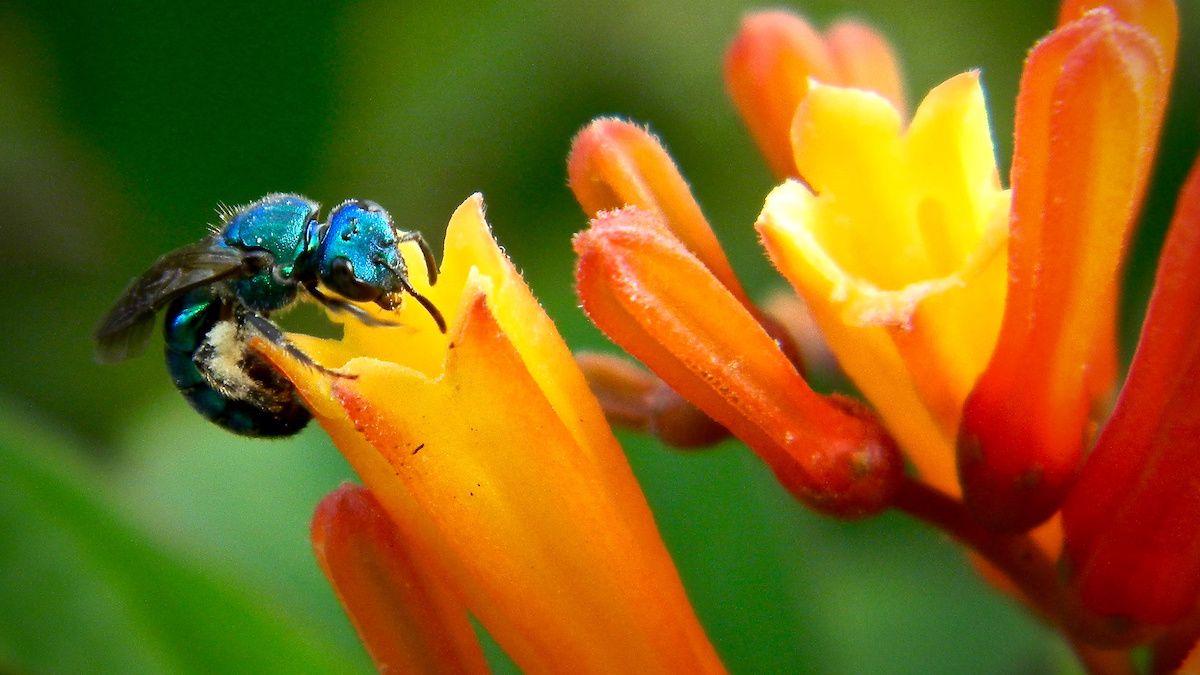

A blue bee on a firebush in Palm Beach, Florida on Sept. 10, 2016. Bob Peterson / CC BY 2.0
Scientists have “rediscovered” a rare blue bee that they feared was extinct.
Until this spring, the “ultra-rare” blue calamintha bee (Osmia calaminthae) had only been observed in four locations in central Florida, and it hadn’t been seen at all since 2016. So when Florida Museum of Natural History research team Chase Kimmel and Jaret Daniels set out to document the bee’s population status and habits, they weren’t sure what they would find.
“I was open to the possibility that we may not find the bee at all so that first moment when we spotted it in the field was really exciting,” Kimmel, a postdoctoral researcher, said in a museum press release.
#Florida’s rare blue calamintha bee was feared extinct until researchers in @jcdaniels lab rediscovered the species this spring in Lake Wales Ridge. Look how BLUE! #DaBaDeeDaBaDie 😍🐝🐝🐝 #UFBugs
Story: https://t.co/PnSuDJoX4O pic.twitter.com/ju4iQrBloQ— Florida Museum (@FloridaMuseum) May 7, 2020
Kimmel first spotted the bee March 9, he told USA TODAY in an email. Since then, he has spotted the elusive pollinator in three of its previous locations and six additiona locations, according to the museum.
The research could have important implications for the bee’s chances of survival. Florida’s State Wildlife Action Plan lists the bee as a species of greatest conservation need, and the study will help determine if it warrants Endangered Species Act protections.
The bee is so vulnerable in part because it is thought to rely on a threatened plant called Ashe’s calamint and live only in Florida’s Lake Wales Ridge region, a hotspot of biodiversity that the museum calls “one of the nation’s fastest-disappearing ecosystems.”
The ridge hosts so much unique life because, when most of Florida was underwater, it was raised above the waves in high sand dunes that acted like islands, giving isolated ecosystems a chance to flourish. Now, these habitats are islands of pine scrub in a sea of orange groves.
“It’s one thing to read about habitat loss and development and another to be driving for 30-40 minutes through miles of orange groves just to get to a really small conservation site,” Kimmel said. “It puts into perspective how much habitat loss affects all the animals that live in this area.”
The bee also exhibits unique behaviors. It gathers pollen by bobbing its head side to side to collect it on its facial hairs. The very first time he saw the bee, Kimmel got a chance to see this in action.
“We observed a shiny little blue bee grabbing the flower and rubbing its head on the top portion of the flower two or three times before moving on to another flower,” Kimmel told CNN. “In reading about this unique behavior we were pretty shocked to see it.”
Kimmel and Daniels’ research is set to last two years and determine the bee’s feeding and nesting habits. So far, the team has found another plant the bee will use if it can’t find Ashe’s calamint.
The research has been hampered somewhat by the coronavirus pandemic, since travel restrictions mean Kimmel is in the field alone during the bee’s flight season from mid-March to early May.
“It’s a very time-limited flight. Now is when the bulk of that activity has to take place,” Daniels, who is acting as Kimmel’s adviser and is also the director of the museum’s McGuire Center for Lepidoptera and Biodiversity, said in the press release. “Chase is doing a fantastic job and we’re getting a lot of great data, but if it wasn’t for the COVID-19 virus we would have had more people in the field, so it has definitely scaled back what we’re able to do.”
- Beat the COVID-19 Blues With These Wildlife and Nature Livecams ...
- Bees and Beekeepers Feel the Sting of Trump Administration's Anti ...
- Coronavirus Lockdowns Keep Bees at Home and Put Crops at Risk - EcoWatch
- Could Rediscovery of Rare Owl Be a Hopeful Sign for Other 'Lost Birds'?

 233k
233k  41k
41k  Subscribe
Subscribe 